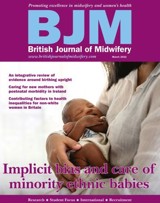References
Does training affect understanding of implicit bias and care of black, Asian and minority ethnic babies?

Abstract
Background
In the UK, there are huge inequities in maternal and neonatal mortality, yet there appears to be very little training to address this for midwives. This quality improvement project aimed to address this by providing training on implicit bias, stereotyping and clinical assessment of babies from black, Asian and minority ethnic families.
Methods
A training package was created and delivered to 67 midwives and students on placement at the Yeovil District NHS Foundation Trust on implicit bias, structural racism and clinical assessment of babies from black, Asian and minority ethnic groups. Pre- and post-training surveys were completed and descriptive statistical analysis alongside thematic analysis was used to analyse the findings.
Results
It was evident that midwives benefited from the training, as pre-session surveys noted that many midwives were unaware of the factors influencing the care of women and babies from black, Asian and minority ethnic families. After the training, they identified a wish to change their practice to be more inclusive.
Conclusions
The training package was well evaluated; however, more training and research is needed to improve the safety of mothers and babies from black, Asian and minority ethnic families.
Between 2000 and 2017, the worldwide maternal mortality rate fell by 38% (World Health Organization (WHO), 2019). Despite this welcome decline, it is not spread evenly across the world, with the maternal mortality ratio in low-income countries in 2017 being 462 per 100 000 women compared to 11 per 100 000 women in high-income countries (WHO, 2019). Between 2017 and 2019, the UK's maternal mortality ratio was 8.8 per 100 000 (Knight et al, 2021a). The difference in maternal mortality ratio between low- and high-income countries may be expected as a result of inadequate access to care and equipment (WHO, 2019). However, within the UK, there are huge disparities in maternal mortality rates. In 2016–2018, for every 100 000 black women who gave birth, 34 died. For every 100 000 Asian women who gave birth, 15 died. In comparison, eight white women per 100 000 died (Knight et al, 2020). In 2021, a UK report into maternal deaths revealed that there has been no statistically significant change in these disparities since 2014 (Knight et al, 2021b). In the USA, rates are similar, with maternal mortality being three times higher in black women than white women (Saluja and Bryant, 2021). Limb (2021) argued that maternity inequity was likely to increase as a result of the COVID-19 pandemic.
Register now to continue reading
Thank you for visiting British Journal of Midwifery and reading some of our peer-reviewed resources for midwives. To read more, please register today. You’ll enjoy the following great benefits:
What's included
-
Limited access to our clinical or professional articles
-
New content and clinical newsletter updates each month

